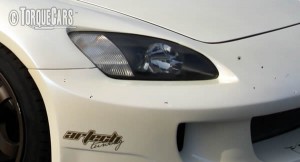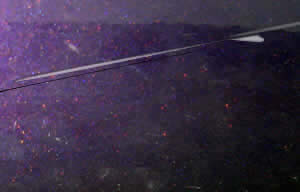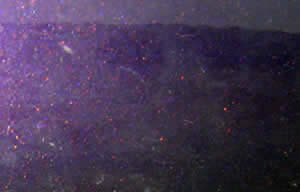Removing stone chips from your precious paint work
"Stone chip removal (for potato chip removal try Ketchup!)"
 One of the most annoying things are getting chips on the bonnet and I'm not talking about the stuff you get from the local 'Berts Fryup'.
One of the most annoying things are getting chips on the bonnet and I'm not talking about the stuff you get from the local 'Berts Fryup'.
The more loose stones there are on the road the more likely it is to pick up a stone chip. Fast roads and higher speeds mean deeper and bigger stone chips.
The more miles you clock up the worse it gets. Although cars can have a protective film applied to resist stone chips most people are left with pitted bonnets that look really unsightly and can easily start to rust.
Invisible repairs to stone chips take time and patience.
Step 1: cleaning out the area. Use a solvent cleaner such as IPA or similar. This is especially important if the chip has gone through to the metalwork below and if not treated then the dreaded metal cancer (rust) will start to take hold. All residue, dust grime and film need to be removed as the new paint will not adhere to this. If the chip goes through to the bare metal you need to clean into the metal work with a small wire brush, pen with a fibreglass tip or even a sharp metal knife, although you need to be careful not to make the damage deeper. If rust has appeared you need to scrape away all of the rust and include an area around the rust spot to ensure that no small traces of rust remain. You then need to coat the area exposed with rust inhibitor such as curite, kurust or similar product, which, kills rust, turning it into a stable surface to paint on and inhibits future rust from forming.
Step 2: paint selection. When manufacturers spray a car there is typically an undercoat a main coat (sometimes several layers of main coat) and in the case of some metallic and special finished a top coat of clear lacquer. This layering needs to be replicated when touching up. The thinner the paint the better - many touch up paints are too blobby and this makes it much harder to get a smooth finish. I found that the 'nail varnish' style paint brush and pots work the best.
Step 3: Base coat. First apply a thin layer of the base coat - choose a light colour base for light top coats but any colour for dark paints. Wipe any excess paint away from the surrounding area being careful not to smudge or smear. Leave for an hour to dry.
Step 4: Apply the main coat - build this up in 3-8 very thin layers and you should leave for an hour at least between coats (thin coats will generally dry in this time). Again be careful to wipe away any excess paint from the surrounding area the paint should now be very slightly higher than the surrounding area.
Step 5: Finishing the surface - Allow at least 3-4 hours from the time of applying the last paint then smooth over with a fine grit wet and dry paper (make sure the paper is wet and start with a fine grade and switch to the finest grade to finish as this will save a bit of time) in a sanding block. The chip is only small so you only need to use a small area of sand paper and a tiny block - a square piece of chalk, end of a carpenters pencil or similar should suffice as a sanding block. This should take the layer of paint down the the level of the surrounding paint work.
Step 6: With a rubbing or cutting paste gradually rub over the area and blend in the new paint with the faded paint on the car in a gentle circular motion.
Step 7: If metallic paint then put the final top lacquer coat on and again smooth with a fine grit wet and dry paper in a sanding block and repeat with a rubbing or cutting paste.


Long scratches can be repaired in a similar way but take a lot more patience and it is vital to ensure that the new paint only enters the area where the damage is. Instead of a brush you should aim to use a single bristle at an acute angle to the surface so the scratch guides the bristle along. Many stone chips and slight scratches, especially those on light paint, can be removed with cutting paste so it is well worth starting with this to see if the damage is only superficial.
Note when using cutting paste - start off lightly and repeat a few times - each rub removes microns of paint and eventually you will rub through the paint (you must never use an electric buffer with cutting paste unless you want large white circles left where the paint has been removed!).
If you liked this page please share it with your friends, drop a link to it in your favourite forum or use the bookmarking options to save it to your social media profile.
Check out TorqueCars new YouTube channel, and see their awesome new content...
Feedback
Please use our forums if you wish to ask a tuning question, and please note we do not sell parts or services, we are just an online magazine.
Help us improve, leave a suggestion or tip
